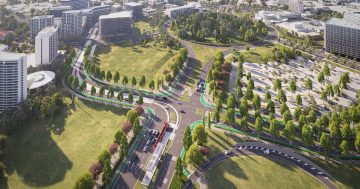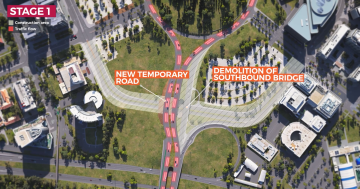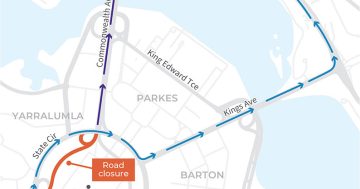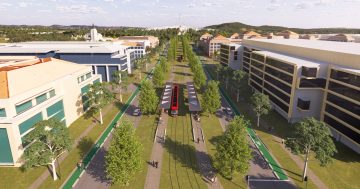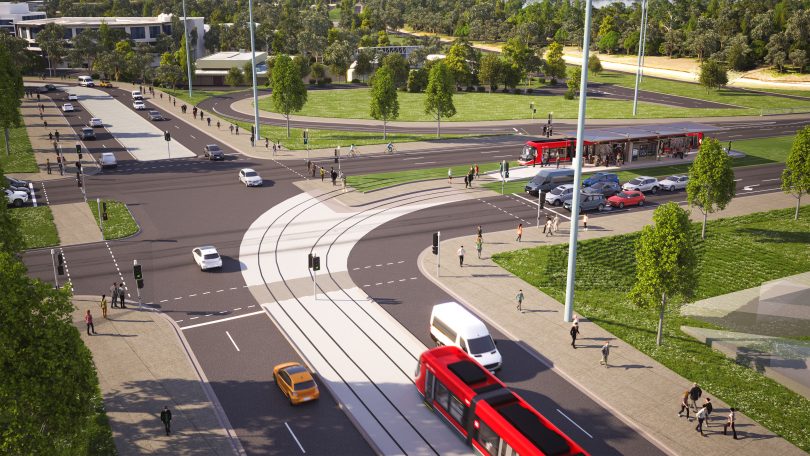
The first major works will be the raising of London Circuit to meet Commonwealth Avenue, as seen here in this artist’s impression. Image: ACT Government.
Commuters have been warned to prepare for years of disruption on the southern gateway to the city as work ramps up on building light rail to Woden.
The ACT Government says they face years of lane closures on Commonwealth Avenue and traffic diversions to other main roads such as Parkes Way and Kings Avenue.
It says constructing the first leg of the light rail extension to Commonwealth Park via City West will disrupt traffic to and in the city centre for up to four years, with the first major works to get underway from the second quarter of next year.
Commonwealth Avenue, which carries 55,000 vehicles a day, may only carry about a fifth of the normal peak volumes, dropping from 5,200 vehicles per hour to as low as 1,100 vehicles per hour.
Kings Avenue could carry more than 20 per cent more traffic in the morning and afternoon peaks, while Parkes Way between Kings Avenue and the City could be up more than 45 per cent in the morning and almost 60 per cent in the afternoon.
But the government would like to see as many people as possible use the extra buses that will be on call or change their travel times to thin out the number of people using the roads during peak times.
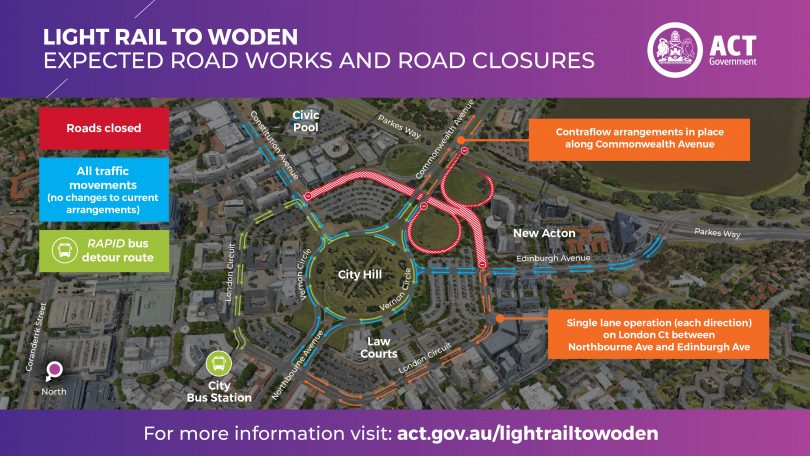
Map of light rail road closures. Image: ACT Government.
Transport and City Services Minister Chris Steel has formed a Disruption Taskforce to manage the traffic upheaval, bringing together expertise from across government in road and public transport network planning, behaviour change, community engagement and communications to plan for the multi-year build.
The Taskforce will look at infrastructure improvements to support traffic flow such as intersection and road improvements, encouraging changes in routes and travel times to spread peak congestion and providing more public transport and active travel options, including more bus services on relevant routes.
Mr Steel said commuters would be advised almost daily of the best travel routes and times through digital channels and on-road, real-time variable message boards.
“Construction at the southern end of the CBD will mainly impact those coming from the southside into the City, but there will be flow-on impacts across the road network,” Mr Steel said.
For example, traffic on the Monaro Highway may increase 46 per cent during the morning peak.
Mr Steel said he had written to major employers such as the Commonwealth departments in the Parliamentary Triangle about flexible working hours and later starting times to help minimise the number of vehicles on the road during the morning and afternoon peaks.
Canberrans can also expect an update to the bus timetable to accommodate route changes and extra services.
The first major works of the next stage of light rail involve raising London Circuit to provide an at-grade intersection with Commonwealth Avenue, but minor works are expected to commence in a few weeks and the first site compounds will be installed next month.
Raising London Circuit will involve the demolition of the cloverleaf ramps and overpasses and result in road closures, including London Circuit.
Mr Steel has ruled out compensation for businesses affected along the route but said the government would be working with them to minimise disruption and help them navigate the construction period.
He said the government was committed to getting on with light rail, which was necessary to avoid even worse congestion in the years to come as Canberra grows.
“The whole reason we’re building light rail is to try to bust congestion and provide a more sustainable and better-connected city so that we don’t grow into a city like Melbourne and Sydney that have significant congestion problems,” he told the ABC.
The government will provide more details about its traffic disruption alleviation measures over the coming months.
A map of future works and road closures is available on the Light rail to Woden website.
Stage 2B to Woden through the Parliamentary Triangle is still working its way through the multi-level approvals process.












